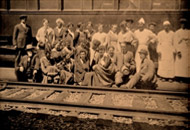Union County was created by the state legislature in 1785 and consisted of 540 square miles. One of the first white settlers was most likely James Mcllwaine and a group of Scotch-Irish Protestants who came from Virginia and Pennsylvania around 1751. Soon large numbers of Quakers and others joined these settlers. Baptists established an entire congregation on lower Fairforest Creek 1760. A common house of worship for the various denominations was built in the Brown’s Creek area. The church was called “union” church and in 1785 in honor of the church the county was named Union.
Residents were active on both sides during the Revolutionary War. There were at least five battles within the county, the most important of these being at Blackstock’s on November 20, 1780. Here, the state militiamen, under Thomas Sumter defeated a British force led by Banastre Tarleton.
In 1786, a log jail and court house were built and space for public buildings had been donated by the county’s greatest Revolutionary War hero Colonel Thomas Brandon.
After 1800, cotton became king and large plantations began to appear in the fertile southern parts of Union County. Due to poor soil conservation, the fields became eroded by the 1830’s. In 1858, local merchant and railroad entrepreneur John L Young linked Union with the Union and Spartanburg Railroad.
There were many Union County men who fought for the Confederacy, following the war they were very active in resisting the tyranny of Reconstruction. In February of 1871 the Union Country Ku Klux Klan staged the largest raid in the South.
In 1893 the Union Cotton Mill was started by Thomas Cary Duncan and gave some relief to the post war poverty that had hit the county following the Civil War. By 1907 the county had about 4,075 workers tending 7,645 looms and 285,800 spindles.
After World War II a second phase of industrial development hit the county. Cotton growing steadily declined after 1920 and had almost disappeared by the 1970s. It was replaced by forestry, cattle raising and soybean farming. Due to the growing forests, the deer returned and drove out the soybean farms. Although there have been changes in the county, history has remained a big presence in the county, with many of the inhabitants of Union County being descended from longtime residents.
Information compiled and written by Anna Lee – 2014, with assistance from Edgar, Walter B., ed. The South Carolina encyclopedia. Columbia, SC: University of South Carolina Press, 2006 and the South Carolina Gazetteer by J.H. Moore, 1989.


Share Your Comments & Feedback: